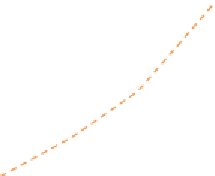Environmental Engineering Reference
In-Depth Information
1
Core A
Core B
Core C
Core D
0.8
0.6
0.4
0.2
0
0
0.2
0.4
0.6
0.8
1
Water Saturation (S
w
)
Figure 5.5
Evaluated coefficient for the core samples (After Ghazanfari, 2013a)
5.8.4.3
Off-diagonal relative permeability coefficients for oil-water
coupling
[
and
Evaluation of the off-diagonal relative EO permeability coefficients is one of
the major challenges when using two-phase flow principles with coupling
between the phases. Experimental procedures similar to those employed in
evaluation of the off-diagonal relative permeability coefficients under pres-
sure gradient cannot be used for the electrical gradient application. It is
difficult to find experimentally the flow of one phase generated due to the
applied electrical gradient in the other phase simply because in practice the
electrical gradient cannot be applied solely to one phase in the pore space.
To simplify the evaluation, it is assumed that the EO body force occurs in
the water phase only since the applied electric field cannot create appre-
ciable EO body force in the oil phase, as discussed above. This implies that
even though the electric field is applied to the entire pore fluid simultane-
ously (both the water and the oil phases), the coupling coefficient,
k
er,ow
,
can be evaluated experimentally by measuring the quantity of oil phase
produced only by assuming that EO body force takes affect in the water
phase and not in the oil phase.
The volume of oil production at cathode was monitored for 36 hours
during the EK tests of the rock cores designated A, B, C, and D. Once again,
knowing the measured volume of the produced oil, the applied electrical
gradient and the EO permeability of the core, the
k
er,ow
coefficient could be
k
k
]
er wo
,
er ow
,












































Search WWH ::

Custom Search